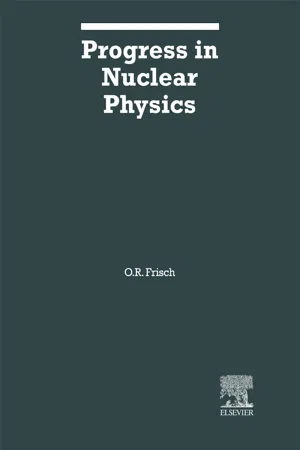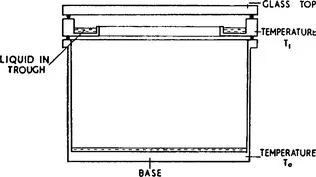![]()
1
THE DIFFUSION CLOUD CHAMBER
Publisher Summary
This chapter discusses the diffusion cloud chamber. Expansion cloud chambers have been extensively used in cosmic ray research, and early experiments used randomly operated chambers. The rate of amassing data was limited by the short duration of the sensitive time after expansion and also by the long recovery time between expansions. It was the work of Langsdorf, who used a thermal gradient to obtain conditions of supersaturation, that gave the most promising results. To use one-dimensional equations to describe the diffusion and heat transfer, the effect of the walls of the chamber must be neglected, and for further simplification of the theory, the vapor is treated as a perfect gas. For stable conditions in the diffusion chamber, the density of the gas vapor mixture must decrease with the height above the base. Diffusion chambers have been largely operated using solid carbon dioxide as the primary coolant and cold temperatures have consequently been limited to about −70°C. It is desirable to achieve as great a sensitive depth as possible to utilize the chamber efficiently. Diffusion chambers have rather limited application in the field of cosmic ray research. However, it is possible that they may prove useful in the study of the structure of extensive showers where the simplicity of operation would allow several chambers to be employed in an experiment. They may also be used with counter control.
Although it is only during the past few years that diffusion cloud chambers have come into common use, it was as long ago as 1936 that experiments with chambers operating on the diffusion principle were started. A measure of success was achieved by LANGSDORF (1936–7) and later (1939) he published an account of a satisfactory, though rather complicated, diffusion cloud chamber. No further work was reported until NEEDELS and NIELSEN (1950), COWAN (1950) and MILLER, FOWLER and SHUTT (1951) described satisfactory results obtained with fairly simple designs of chamber. Since then numerous workers have constructed similar chambers and their application for research in nuclear physics is becoming widespread. In addition small chambers of very rudimentary design are being used for demonstration purposes in many laboratories.
Expansion cloud chambers have been extensively used in cosmic ray research and early experiments used randomly operated chambers. The rate of amassing data was limited by the short duration of the sensitive time after expansion and also by the long recovery time between expansions. Much effort therefore was directed towards developing a chamber which had a longer sensitive time (BEARDEN, 1935; FRISCH, 1935 and MAIER-LEIBNITZ, 1939) or required a shorter interval between expansions (BRINKMAN, 1936; SHIMIZU, 1921; GAERTTNER and YEATER, 1949). At the same time other workers looked for new principles of operation which might give continuous sensitivity. VOLLRATH (1936) obtained some success using a chemical method in which hydrochloric acid vapour and water vapour are allowed to diffuse together. The resulting mixture is supersaturated and droplets formed on cosmic ray tracks were observed but not photographed. By passing air over water at 70°C and thence into an observation channel maintained at room temperature by a surrounding water jacket, HOXTON (1934) produced conditions of continuous supersaturation. Droplet condensation was produced in the presence of electrical discharges but not observed by radioactive ionization.
It was the work of LANGSDORF (1936) who used a thermal gradient to obtain conditions of supersaturation which gave the most promising results. Methyl alcohol produced at the top of the chamber was allowed to diffuse downwards to the base of the chamber which was kept at a low temperature. An intermediate region of the chamber was observed where the supersaturation was sufficient to give condensation on ion tracks formed by cosmic rays but there was a background of continuous rain making the contrast insufficient for photographic records to be obtained.
It is this last type of continuously sensitive cloud chamber which has been rapidly developed during the past few years and is now universally referred to as the diffusion cloud chamber. Let us consider the basic requirements of such a chamber and look into the conditions necessary for satisfactory operation.
In Fig. 1 the essential details of the diffusion cloud chamber are illustrated. The body of the chamber containing the gas-vapour mixture is thermally connected to the base which is cooled to some low temperature T0. Near the glass top of the chamber is a trough containing a liquid which is vaporized by maintaining it at some temperature T1 greater than T0; a thermal gradient is therefore set up between top and bottom of the chamber.
Fig. 1 Basic design of diffusion cloud chamber.
The gas at the top of the chamber is saturated with the vapour of the liquid contained in the trough and this vapour will diffuse downwards towards the cooled base. At the lower temperatures the gas becomes supersaturated with the vapour, the value of the supersaturation increasing as the temperature decreases. With a suitable gas-vapour combination and for appropriate values of T1 and T0 the super-saturation can exceed the critical value necessary to cause drop-wise condensation upon ions. This value was shown by THOMSON (1888) to be given by the expression
where S is the supersaturation, M is the gram molecular weight, d the density, σ the surface tension and K the dielectric constant of the liquid; T is the absolute temperature, R the gas constant and e the charge carried by the ions.
THEORY
LANGSDORF (1939) has determined the supersaturation resulting from certain temperature and vapour density distributions within the chamber. For simplicity he considered the special case where drop-wise condensation of the vapour can be neglected, a condition which could only be attained in practice by the elimination of all condensation nuclei, whether charged or uncharged, from the volume of the chamber. In order to use one-dimensional equations to describe the diffusion and heat transfer, the effect of the walls of the chamber must be neglected and for further simplification of the theory the vapour is treated as a perfect gas.
The total energy flux through the chamber can then be expressed by the equation
where Cp is the specific heat of the vapour, mv the vapour flux in g cm−2 sec−1 and K = K0(1 + at) the relation between the thermal conductivity of the gas vapour mixture and the temperature t. t = (T – T0) is the difference in temperature between some height z in the chamber and the base temperature T0, and dt/dz the temperature gradient along the z-axis of the cha...



